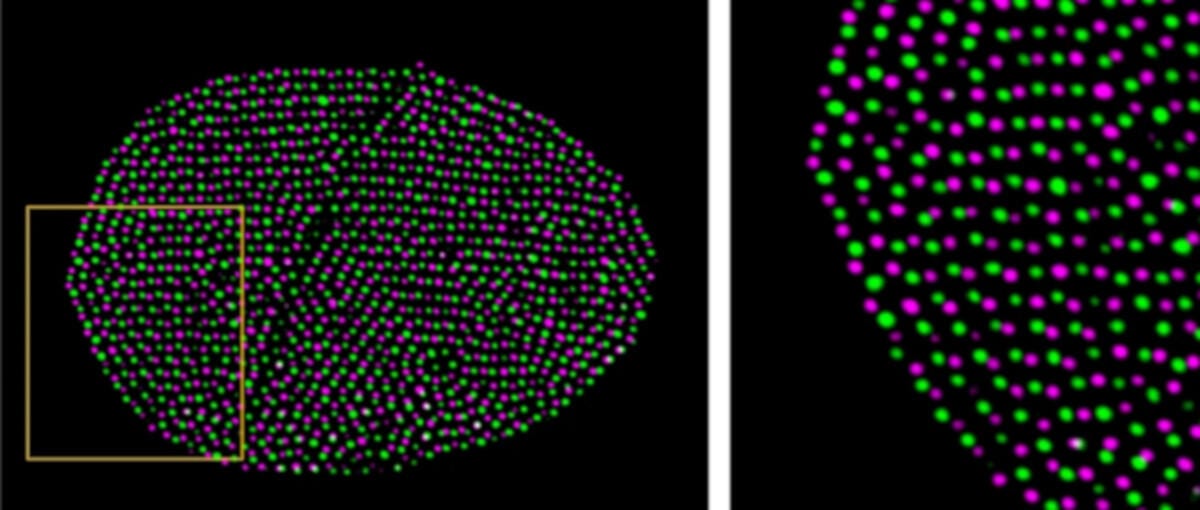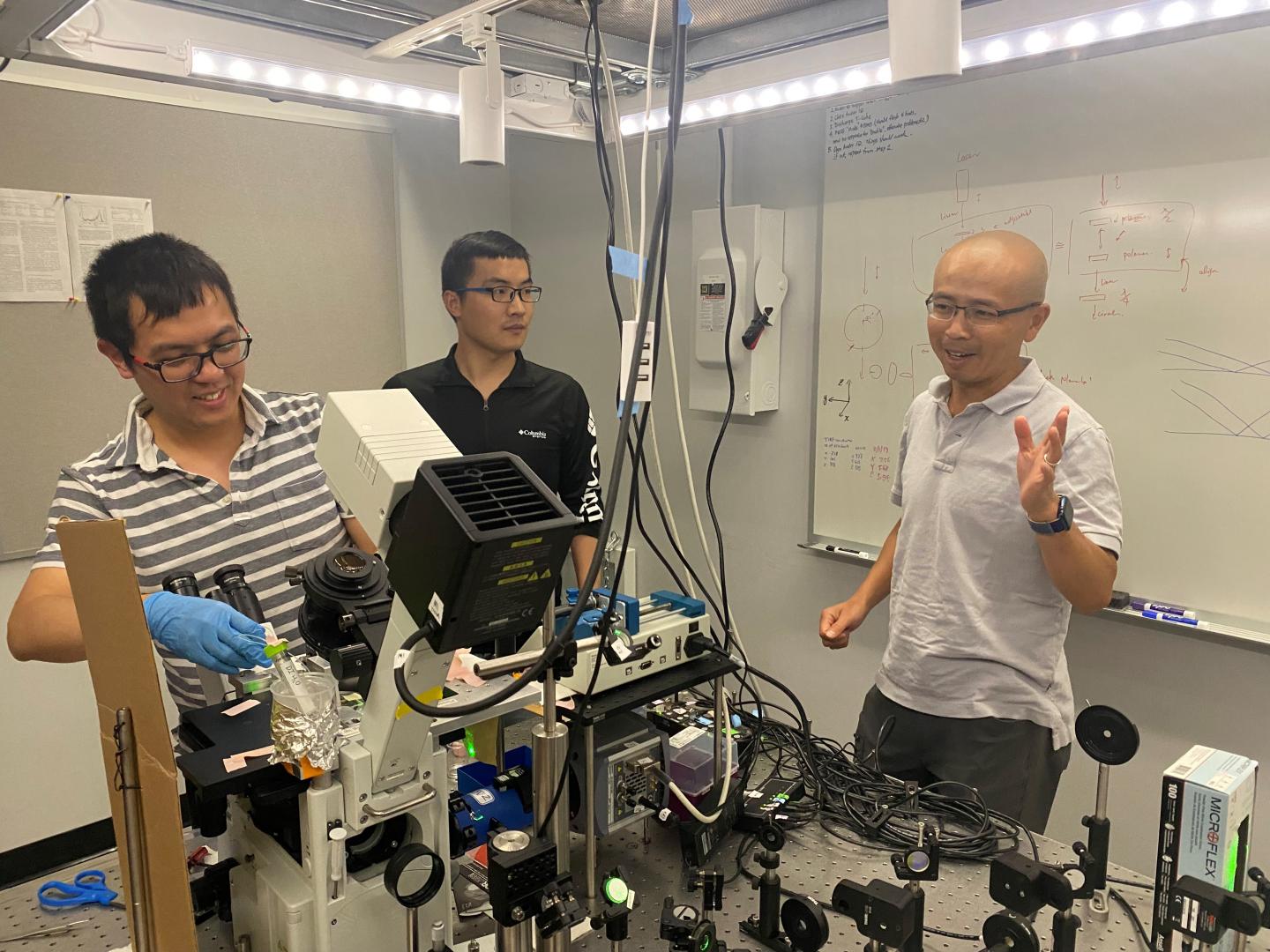
Crystalline 3D patterns of gold-polystyrene nanoparticles. Images captured via STEM tomography at the Molecular Foundry.
(Credit: Berkeley Lab)
Scientists at Berkeley Lab, UC Berkeley design 3D-grown material that could speed up production of new technologies for smart buildings and robotics
Crystallization is one of the most fundamental processes found in nature – and it’s what gives minerals, gems, metals, and even proteins their structure.
In the past couple of decades, scientists have tried to uncover how natural crystals self-assemble and grow – and their pioneering work has led to some exciting new technologies – from the quantum dots behind colorful QLED TV displays, to peptoids, a protein-mimic that has inspired dozens of biotech breakthroughs.
Now, a research team led by scientists at the Department of Energy’s Lawrence Berkeley National Laboratory (Berkeley Lab) and UC Berkeley has developed a nanoparticle composite that grows into 3D crystals. The scientists say that the new material – which they call a 3D PGNP (polymer-grafted nanoparticle) crystal in their recently published Nature Communications study – could lead to new technologies that are 3D-grown rather than 3D-printed.
“We’ve demonstrated a new lever to turn, so to speak, to grow a crystalline material into a composite or structured material for applications ranging from nanoscale photonics for smart buildings to actuators for robotics,” said Ting Xu, senior author of the study. Xu is a faculty senior scientist in Berkeley Lab’s Materials Sciences Division and professor of chemistry and materials science and engineering at UC Berkeley.
Xu said that their new method is compatible with the demands of mass manufacturing. “Many smart minds have designed elegant chemistries, such as DNAs and supramolecules, to crystallize nanoparticles. Our system is essentially a blend of nanoparticle and polymers – which are similar to the ingredients people use to make airplane wings or automobile bumpers. But what’s even more interesting is that we didn’t expect our method to be so simple and so fast,” Xu said.
A chance discovery
Lead author Yiwen Qian, a Ph.D. student researcher in the Xu Group at UC Berkeley, discovered the 3D PGNP nanocrystals by chance in an ordinary lab experiment.
A couple of days before, she had left a solution of toluene solvent and gold nanoparticles grafted with polystyrene (Au-PS) in a centrifuge tube on a lab counter. When she looked at the sample under a transmission electron microscope (TEM), she noticed something odd. “Nanoparticles had crystallized quickly. That was not a normal thing to expect,” she said.
To investigate, Xu collaborated with Peter Ercius, a staff scientist at Berkeley Lab’s Molecular Foundry, and Wolfgang Theis and Alessandra DaSilva of the University of Birmingham, all of whom are widely regarded for their expertise in STEM (scanning transmission electron microscopy) tomography, an electron microscopy technique that uses a highly focused beam of electrons to reconstruct images of a material’s 3D structure at high resolution.
Using microscopes at the Molecular Foundry, a world-leading user facility in STEM tomography, the researchers first captured crystalline 3D patterns of the Au-PS nanoparticles.
On the hunt for more clues, Xu and Qian then deployed nuclear magnetic resonance spectroscopy experiments at UC Berkeley, where they discovered a tiny trace of polyolefin molecules from the centrifuge tube lining had somehow entered the mix. Polyolefins, which include polyethylene and polypropylene, are some of the most ubiquitous plastics in the world.
Qian repeated the experiment, adding more polyolefin to the Au-PS solution – and this time, they got bigger 3D PGNP crystals within minutes.
Xu was surprised. “I thought, ‘This shouldn’t be happening so fast,’” she recalled. “Crystals of nanoparticles usually take days to grow in the lab.”
A boon for industry: growing materials at the nanolevel
Subsequent experiments revealed that as the toluene solvent quickly evaporates at room temperature, the polyolefin additive helps the Au-PS nanoparticles form into 3D PGNP crystals, and to “grow into their favorite crystal structure,” said Qian.
In another key experiment, the researchers designed a self-assembling 100-200-nanometer crystalline disc that looks like the base of a pyramid. From this stunning demonstration of mastery over matter at the nanolevel, the researchers learned that the size and shape of the 3D PGNP crystals are driven by the kinetic energy of the polyolefins as they precipitate in the solution.
Altogether, these findings “provide a model for showing how you can control the crystal structure at the single particle level,” Xu said, adding that their discovery is exciting because it provides new insight into how crystals form during the early stages of nucleation.
“And that’s challenging to do because it’s hard to make atoms sit next to each other,” Ercius said.
The new approach could grant researchers unprecedented control in fine-tuning electronic and optical devices at the nanolevel (billionths of a meter), Xu said. Such nanoparticle-scale precision, she added, could speed up production and eliminate errors in manufacturing.
Looking ahead, Qian would like to use their new technique to probe the toughness of different crystal structures – and perhaps even make a hexagonal crystal.
Xu plans to use their technique to grow bigger devices such as a transistor or perhaps 3D-print nanoparticles from a mix of materials.
“What can you do with different morphologies? We’ve shown that it’s possible to generate a single-component composite from a mineral and a polymer. It’s really exciting. Sometimes you just need to be in the right place at the right time,” Xu said.
Original Article: This Crystal Impurity Is Sheer Perfection
More from: Lawrence Berkeley National Laboratory | University of California Berkeley | University of Birmingham
The Latest Updates from Bing News & Google News
Go deeper with Bing News on:
3D-grown technologies
- Yellow raises $5M from A16z for Gen AI-powered 3D modeling tool
Yellow has raised $5 million in seed funding from A16z Games to fund further development of its gen AI-powered 3D character modeling tool.
- Hands on With the Meshy.ai Text-to-3D Service
There are plenty of Text-to-3D services popping up in recent months, and honestly most of them produce quite poor results. In fact I have been trying out quite a few, but the qual ...
- Nextech3D.ai Receives Large 3D AI Purchase Order from Blue Chip Enterprise Customer
Nextech3D.ai Continues to Sign New & Renewal 3D Modeling Deals plus AR Visualization For Enterprise EcommerceCompany Has Expanded into AI CAD-3D Rendering to Capture Larger Market Share ...
- China's home-grown general-purpose humanoid jogs out at 6 km/h
The Beijing Humanoid Robot Innovation Center has unveiled Tiangong, an electrically-driven general-purpose humanoid that's capable of stable running at 6 km/h, while also able to tackle slopes and ...
- 3D and 4D Technology Market CAGR of 16.0%, Innovative Strategies for Harnessing Future Market Size Growth
Download Free Sample of This Strategic Report with Industry Analysis @:- https://reportocean.com/industry-verticals/sample-request?report_id=bw1842 ...
Go deeper with Google Headlines on:
3D-grown technologies
[google_news title=”” keyword=”3D-grown technologies” num_posts=”5″ blurb_length=”0″ show_thumb=”left”]
Go deeper with Bing News on:
3D PGNP
- The Best 3D Printers for 2024
More affordable than ever, 3D printers are booming for personal, professional, and educational use. Here's everything to know before you buy one, along with the top models from our hands-on testing.
- Best 3D Printer for 2024
We've tested and reviewed several models to find the top 3D printers, including options from Prusa, Anycubic, Elegoo, Bambu Lab and more. James has been writing about technology for years but has ...
- 3D printing overtakes McLaren F1 engineering
McLaren says they are now 3D printing more prototype parts for their Formula 1cars than engineering them, heralding a new era of sustainable rapid prototyping in a sport trying to get to net zero ...
- Best 3D modeling software of 2024
If you're all about bringing ideas to life, the best 3D modeling software is essential. Widely used across the automotive industry, film-making, engineering, gaming, product design, and for 3D ...
- Best 3D printers of 2024
We tested almost thirty of the best 3D printers - and these are the ones we recommend, whether you're a beginner, on a budget, making crafts, or a professional designer in the studio. 3D printing ...
Go deeper with Google Headlines on:
3D PGNP
[google_news title=”” keyword=”3D PGNP” num_posts=”5″ blurb_length=”0″ show_thumb=”left”]









